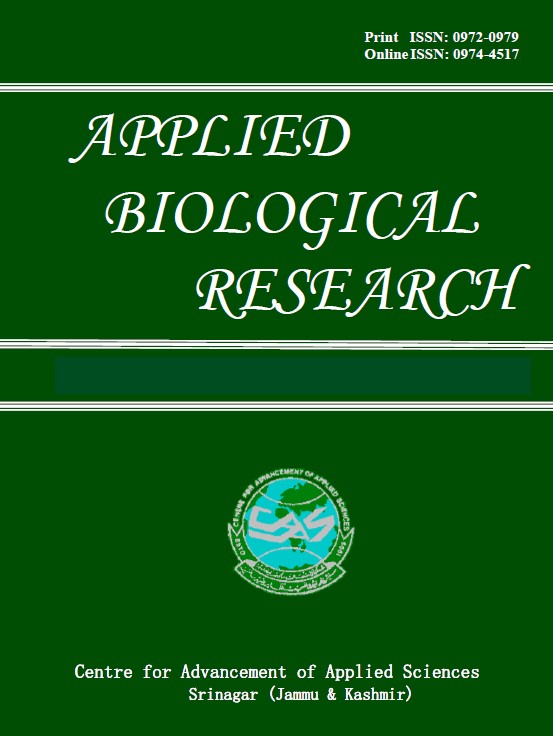ANTICANCER MECHANISMS OF Commelina forskaolii EXTRACT THROUGH INDUCTION OF FERROPTOSIS IN HT-29 COLON CANCER CELL LINES
DOI:
https://doi.org/10.48165/abr.2025.27.01.34Keywords:
Anticancer, antioxidants, ferroptosis, colon cancer, Commelina forskaolii, Rat’s ear plantAbstract
Colon cancer is the 3rd most prevalent cancer globally, presenting significant epidemiological and economic challenges. Natural products have shown promise as effective alternatives to chemotherapy. The present study was aimed to study the anticancer potential of rat’s ear (Commelina forskaolii) on HT-29 colon cancer cells, focusing on cytotoxic activity, antioxidant potential, and underlying molecular mechanisms. The cytotoxic activity of the ethanolic extract of C. forskaolii was assessed by measuring IC₅₀ value on HT-29 cell lines, enzymatic antioxidant potential and heme oxygenase activity. Gene expression and cell cycle analyses were performed to explore molecular mechanisms. The extract demonstrated significant cytotoxic activity with an IC₅₀ value of 27.4 ± 0.25 μg mL⁻¹. Cell cycle analysis showed that C. forskaolii effectively arrested the cells at G₀/S phase. Additionally, the study revealed an increase in lipid peroxidation and intracellular iron accumulation, leading to the formation of lipid-iron radicals and triggering ferroptosis. Heme oxygenase-1 (HO-1) was found to regulate cellular iron levels and reactive oxygen species (ROS) generation, where moderate HO-1 activity offered cytoprotection, but excessive activity in cancer cells led to oxidative cell death. The findings suggest that C. forskaolii may serve as a valuable natural treatment for colon cancer, targeting oxidative processes that induce cancer cell death and anticancer activity.
Downloads
References
Agahi, F., Juan-García, A., Font, G., and Juan, C. (2021). Study of enzymatic activity in human neuroblastoma cells SH-SY5Y exposed to zearalenone’s derivates and beauvericin. Food and Chemical Toxicology, 152, 1–8.
Banerjee, P., Basu, A., Wegiel, B., Otterbein, L.E., Mizumura, K., Gasser, M., et al. (2012). Heme oxygenase-1 promotes survival of renal cancer cells through modulation of apoptosis- and autophagy-regulating molecules. Journal of Biological Chemistry, 287(38), 32113–32123.
Bekeschus, S., Freund, E., Wende, K., Gandhirajan, R.K., and Schmidt, A. (2018). Hmox1 upregulation is a mutual marker in human tumor cells exposed to physical plasma-derived oxidants. Antioxidants, 7(11), 1–16.
Bogen, K.T. (2016). A new theory of chemically induced tumorigenesis: Key molecular events and dose-response implications. Advances in Molecular Toxicology, 10, 1–53.
Chang, L.C., Chiang, S.K., Chen, S.E., Yu, Y.L., Chou, R.H., and Chang, W.C. (2018). Heme oxygenase-1 mediates BAY 11-7085 induced ferroptosis. Cancer Letters, 416, 124–137.
Chiang, S.K., Chen, S.E., and Chang, L.C. (2019). A dual role of heme oxygenase-1 in cancer cells. International Journal of Molecular Sciences, 20(1), 39. [https://doi.org/10.3390/ijms20010039].
Glorieux, C., Enríquez, C., González, C., Aguirre-Martínez, G., and Buc-Calderon, P. (2024). The multifaceted roles of NRF2 in cancer: Friend or foe? Antioxidants, 13(1), 1–27.
Gueron, G., De Siervi, A., Ferrando, M., Salierno, M., De Luca, P., Elguero, B., et al. (2009). Critical role of endogenous heme oxygenase 1 as a tuner of the invasive potential of prostate cancer cells. Molecular Cancer Research, 7(11), 1745–1755.
Hadi, N.A., Mahmood, R.I., and Al-Saffar, A.Z. (2021). Evaluation of antioxidant enzyme activity in doxorubicin treated breast cancer patients in Iraq: A molecular and cytotoxic study. Gene Reports, 24, 101285. [https://doi.org/10.1016/j.genrep.2021.101285].
Hill, M., Pereira, V., Chauveau, C., Zagani, R., Remy, S., Tesson, L., et al. (2005). Inhibits rat and human breast cancer cell proliferation: Mutual cross inhibition with indoleamine. The FASEB Journal, 19(14), 1957–1968.*
Huang, X.M., Yang, Z.J., Xie, Q., Zhang, Z.K., Zhang, H., and Ma, J.Y. (2019). Natural products for treating colorectal cancer: A mechanistic review. Biomedicine and Pharmacotherapy, 117, 1–13.
Illian, D.N., Hafiz, I., Meila, O., Utomo, A.R.H., Nuryawan, A., Siregar, G.A., et al. (2021). Current status, distribution, and future directions of natural products against colorectal cancer in Indonesia: A systematic review. Molecules, 26(16), 1–18.
Jang, H.J., Hong, E.M., Kim, M., Kim, J.H., Jang, J., Park, S.W., et al. (2016). Simvastatin induces heme oxygenase-1 via NF-E2-related factor 2 (Nrf2) activation through ERK and PI3K/Akt pathway in colon cancer. Oncotarget, 7(29), 46219–46229.
Jena, A.B., Samal, R.R., Bhol, N.K., and Duttaroy, A.K. (2023). Cellular redox system in health and disease: The latest update. Biomedicine and Pharmacotherapy, 162, 1–21.
Kang, K.A., Piao, M.J., Hyun, Y.J., Zhen, A.X., Cho, S.J., Ahn, M.J., et al. (2019). Luteolin promotes apoptotic cell death via upregulation of Nrf2 expression by DNA demethylase and the interaction of Nrf2 with p53 in human colon cancer cells. Experimental & Molecular Medicine, 51(4), 1–14.
Lee, Y.M., Jeong, G.S., Lim, H.D., An, R.B., and Kim, Y.C. (2010). Methyl ether induces growth inhibition and apoptosis in oral cancer cells via heme oxygenase-1. Toxicology In Vitro, 24(3), 776–782.
Malsawmdawngliana, Z., Zohmachhuana, A., Vabeiryureilai, M., Thangjam, N.M., Lalrinzuali, K., Kumar, N.S., et al. (2021). Antioxidant efficacy and cytotoxicity of ethanol extract of Clerodendrum infortunatum against different cell lines. Indian Journal of Biochemistry and Biophysics, 58(6), 572–581.
Mantovani, G., Macciò, A., Madeddu, C., Mura, L., Gramignano, G., Lusso, M.R., et al. (2002). Quantitative evaluation of oxidative stress, chronic inflammatory indices and leptin in cancer patients: Correlation with stage and performance status. International Journal of Cancer, 98(1), 84–91.
Mosmann, T. (1983). Rapid colorimetric assay for cellular growth and survival: Application to proliferation and cytotoxicity assays. Journal of Immunological Methods, 65(1–2), 55–63.
Nuhn, P., Künzli, B.M., Hennig, R., Mitkus, T., Ramanauskas, T., Nobiling, R., et al. (2009). Heme oxygenase-1 and its metabolites affect pancreatic tumor growth in vivo. Molecular Cancer, 8, 37. [https://doi.org/10.1186/1476-4598-8-37].
Raju, M.V., Chandrasekaran, M.K., Ahalliya, R.M., and Kanniappan, G.V. (2025). Reconnoitering the role of lipid metabolites in ferroptosis. Advances in Redox Research, 14, 100117. [https://doi.org/10.1016/j.arres.2024.100117].
Raju, M.V., Chandrasekaran, M.K., Rajendran, M.S., Kanniappan, G.V., Ahalliya, R.M., Dugganaboyana, G.K., et al. (2024a). Deciphering the therapeutic, larvicidal, and chemical pollutant degrading properties of leaves-mediated silver nanoparticles obtained from Alpinia purpurata. BioResources, 19(2), 3328–3352.
Raju, M.V., Sekar, S., Chandrasekaran, M.K., Rajendran, M.S., and Ahalliya, R.M. (2024b). Evaluation of the antioxidant activity of novel south Indian plant Commelina forskaolii and its prospective anticancer activity in Hep G2 cells. Indian Journal of Natural Products and Resources, 15(1), 65–72.
Ryter, S.W., Alam, J., and Choi, A.M.K. (2006). Heme oxygenase-1/carbon monoxide: From basic science to therapeutic applications. Physiological Reviews, 86(2), 583–650.
Tan, B.L., Norhaizan, M.E., Huynh, K., Yeap, S.K., Hazilawati, H., and Roselina, K. (2015). Brewer’s rice modulates oxidative stress in azoxymethane-mediated colon carcinogenesis in rats. World Journal of Gastroenterology, 21(29), 8927–8934.
Trivedi, P.P., Jena, G.B., Tikoo, K.B., and Kumar, V. (2016). Melatonin modulated autophagy and Nrf2 signalling pathways in mice with colitis-associated colon carcinogenesis. Molecular Carcinogenesis, 55(3), 255–267.
Ukeda, H., Maeda, S., Ishii, T., and Sawamura, M. (1997). Spectrophotometric assay for superoxide dismutase based on tetrazolium salt reduction by xanthine–xanthine oxidase. Analytical Biochemistry, 251(2), 206–209.
Vadde, R., Vemula, S., Jinka, R., Merchant, N., Bramhachari, P.V., and Nagaraju, G.P. (2017). Role of hypoxia-inducible factors (HIF) in the maintenance of stemness and malignancy of colorectal cancer. Critical Reviews in Oncology/Hematology, 113, 22–27.
Wei, R., Zhao, Y., Wang, J., Yang, X., Li, S., Wang, Y., Yang, X., et al. (2021). Tagitinin C induces ferroptosis through PERK-Nrf2-HO-1 signalling pathway in colorectal cancer cells. International Journal of Biological Sciences, 17(11), 2703–2717.
Zani, A.P., Zani, C.P., Din, Z.U., Rodrigues-Filho, E., Ueda-Nakamura, T., Garcia, F.P., et al. (2023). Dibenzylideneacetone induces apoptosis in cervical cancer cells through ROS-mediated mitochondrial damage. Antioxidants, 12(2), 1–34.
Zuo, Q., Wu, R., Xiao, X., Yang, C., Yang, Y., Wang, C., et al. (2018). The dietary flavone luteolin epigenetically activates the Nrf2 pathway and blocks cell transformation in human colorectal cancer HCT116 cells. Journal of Cellular Biochemistry, 119(11), 9573–9582.

